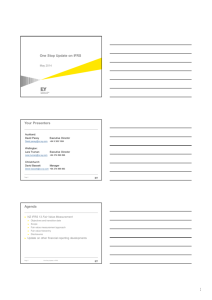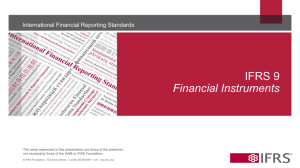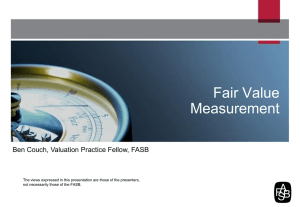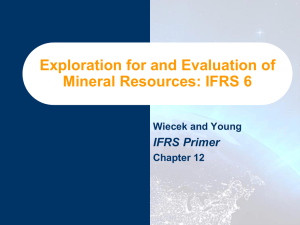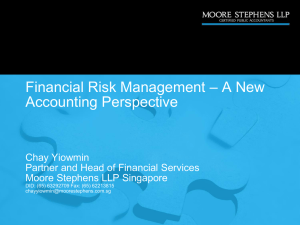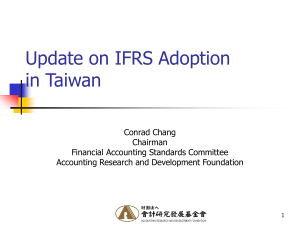Title / divider screen title
advertisement
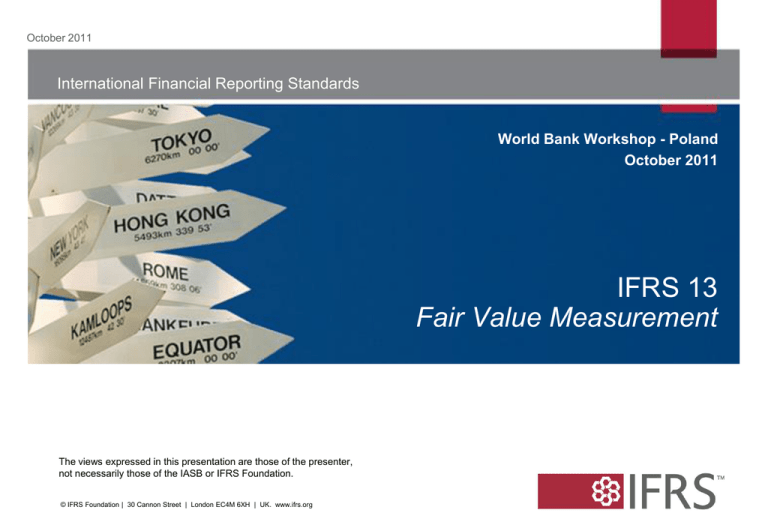
October 2011 International Financial Reporting Standards World Bank Workshop - Poland October 2011 IFRS 13 Fair Value Measurement The views expressed in this presentation are those of the presenter, not necessarily those of the IASB or IFRS Foundation. © IFRS Foundation | 30 Cannon Street | London EC4M 6XH | UK. www.ifrs.org Agenda • Scope of IFRS 13 • Fair value measurement principles • Disclosures about fair value • Effective date and transition IFRS 13 Fair Value Measurement 2 Scope of IFRS 13 “Where fair value is used in IFRSs” • Excluded from scope: – IFRS 2 – IAS 17 • Disclosures not required for: – IAS 19, IAS 26 – IAS 36 fair value less costs of disposal • Not required for measurements similar to fair value: – IAS 2 – IAS 37 – IAS 36 (value in use) IFRS 13 Fair Value Measurement 3 Clarifying the measurement objective 4 Fair value is the price that would be received to sell an asset or paid to transfer a liability in an orderly transaction between market participants at the measurement date. • Exit price – Use vs sale of asset – Fulfilment of liability • Market-based – Not entity-specific • Orderly transaction – Not forced sale or liquidation (even with exit price notion) • Current price – Market conditions at the measurement date IFRS 13 Fair Value Measurement Clarifying the measurement objective 5 Is there a quoted price in an active market for an identical asset or liability? Yes Use this quoted price to measure fair value (Level 1) No Replicate a market price using another valuation technique* (Levels 2 and 3) * A valuation technique must maximise the use of relevant observable inputs and minimise the use of unobservable inputs. IFRS 13 Fair Value Measurement The asset or liability: “What” is being measured? 6 • Unit of account – IAS 41: A biological asset shall be measured on initial recognition and at the end of each reporting period at its fair value less costs to sell… • Characteristics – Which characteristics would a market participant buyer take into account? – – – – IFRS 13 Fair Value Measurement Age and remaining economic life Condition Location Restrictions on use or sale Highest and best use: “What” is being measured? 7 • Fair value assumes a non-financial asset is used by market participants at its highest and best use – The use of a non-financial asset by market participants that maximises the value of the asset – Physically possible – Legally permissible – Financially feasible • Highest and best use is usually (but not always) the current use – If for competitive reasons an entity does not intend to use the asset at its highest and best use, the fair value of the asset still reflects its highest and best use by market participants (defensive value) • Does not apply to financial instruments or liabilities IFRS 13 Fair Value Measurement Valuation premise: “What” is being measured? 8 • A non-financial asset either: – Provides maximum value through its use in combination with other assets and liabilities as a group – Is its value influence by it being ‘operated’ with other assets? – An example: equipment used in production facility – Provides maximum value through its use on a standalone basis – Is its value independent of its use with other assets? – An example: a vehicle or an investment property • Does not apply to financial instruments or liabilities IFRS 13 Fair Value Measurement The exit transaction: “Where” would a transaction happen? 9 • In the principal market: – The market with the greatest volume and level of activity for the asset or liability • Or (if no principal market) in the most advantageous market: – The market that maximises the amount that would be received to sell the asset and minimises the amount that would be paid to transfer the liability • In most cases, these markets will be the same – Arbitrage opportunities will be competed away IFRS 13 Fair Value Measurement Market participants: “Who” would transact for the item? 10 • Market participants are buyers and sellers in the principal (or most advantageous) market who are: – Independent of each other – Not related parties – Knowledgeable and sufficiently informed about the asset or liability and the transaction – Due diligence efforts – Able to enter into a transaction for the asset or liability – Has a use for the asset – Can fulfil the obligation – Willing to enter into a transaction for the asset or liability – Not forced or otherwise compelled • Market participants act in their economic best interest IFRS 13 Fair Value Measurement Liabilities and shareholders’ equity: Transfer notion 11 • Fair value assumes a transfer to a market participant who takes on the obligation – The liability or equity instrument is not extinguished in the transfer – Restrictions on transfer are already reflected in inputs; no additional adjustment required – Some liabilities and equity instruments are held by entities as assets and some are not – Debt instruments vs decommissioning obligations – Fair value reflects the effect of non-performance risk – The risk that the entity will not fulfil the obligation – Includes credit risk IFRS 13 Fair Value Measurement Fair value disclosures 12 • More information for Level 3: – Quantitative disclosure of unobservable inputs and assumptions used – Reconciliation of opening to closing balances – Description of valuation process in place – Sensitivity analysis: – Narrative discussion about sensitivity to changes in unobservable inputs, including inter-relationships between inputs that magnify or mitigate the effect on the measurement – Quantitative sensitivity analysis for financial instruments IFRS 13 Fair Value Measurement Effective date and transition • Effective 1 January 2013 • Earlier application permitted • Prospective application, no comparatives IFRS 13 Fair Value Measurement 13 Differences between IFRS 13 and Topic 820 14 Topic Reason for difference NAV practical expedient Different accounting for investment companies (which in IFRSs may or may not mean investments are measured in accordance with IFRS 13) means IASB cannot yet allow a practical expedient. Deposit liabilities Different requirements in IFRSs and US GAAP (in different locations) for measuring fair value of deposit liabilities Disclosures • IFRS does not allow net presentation of derivatives • IFRS requires quantitative sensitivity analysis for financial instruments • In IFRS non-publicly accountable entities are covered by SME standard IFRS 13 Fair Value Measurement 14 Questions or comments? Expressions of individual views by members of the IASB and its staff are encouraged. The views expressed in this presentation are those of the presenter. Official positions of the IASB on accounting matters are determined only after extensive due process and deliberation. IFRS 13 Fair Value Measurement 15


